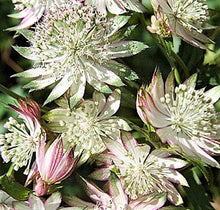Very floriferous and vigorous, Astrantia major 'Star of Billion' (Great Masterwort) features large clusters of tiny white flowers crowded together in a dome-shaped flowerhead, just like pins on a cushion. They are surrounded by an elegant ruff of white papery bracts adorned with green tips. Can be grown in full sun in mild-Summer regions. Flowers excellent for cutting. Patented.
Botanical name: Astrantia major 'Star of Billion'
Form: Perennial
Hardiness Zone: 4-7
Flower Color: White
Foliage type: Basal leaves have 3 to 7 lobes and toothed segments. Cauline leaves are heavily lobed, lanceolate-shaped with a trilobed apex
Bloom time: May-September
Height: 26 inches
Spread: 20 inches
Light requirements: Semi-shade
Plant depth: One inch of soil over root
See "Growing Tips" for more detailed instructions
Form: Perennial
Hardiness Zone: 4-7
Flower Color: White
Foliage type: Basal leaves have 3 to 7 lobes and toothed segments. Cauline leaves are heavily lobed, lanceolate-shaped with a trilobed apex
Bloom time: May-September
Height: 26 inches
Spread: 20 inches
Light requirements: Semi-shade
Plant depth: One inch of soil over root
See "Growing Tips" for more detailed instructions
Tips and Growing Instructions
Visit our How-To Cultivation Library for more growing tips.
Astrantia is very adaptable, and will grow well in full sun, given plenty of water, or in full shade, where foliage is lush, and blooms are few. Ideally, astrantia should be grown where they will receive a few hours of morning light, with dappled shade the rest of the day. While Astrantia easily withstands the harsh winters of the north and midwest, and a wide range of growing conditions throughout the country, it does not fare well with the combined heat and humidity of the south.
Astrantia will grow in heavy clay soils, but better prefers slightly acidic, light rich, loamy soils that retain moisture, but drain off standing water. Plant your bare root astrantia with the crown ½ - 1 inch below the surface of the soil, with the roots spread out and down. Fill in with loose soil and do not pack it down too tightly. Mulch to maintain even moisture. Water regularly and thoroughly to maintain a fairly even soil moisture. It will not survive sustained periods of dry soil.
Astrantia typically bloom from early to mid-summer. The varieties we offer have been bred for an exceptionally long and abundant bloom season, and they produce flowers from early summer right through to early fall. Deadhead spent blooms to encourage continued bloom production. The flowers make long lasting cuts for fresh bouquets, and they dry beautifully for winter interest.
Your astrantia will shrug off the coldest of winters, and be ready to grow and bloom for you, bigger and better, every year! Enjoy!
Visit our How-To Cultivation Library for more growing tips.
Astrantia is very adaptable, and will grow well in full sun, given plenty of water, or in full shade, where foliage is lush, and blooms are few. Ideally, astrantia should be grown where they will receive a few hours of morning light, with dappled shade the rest of the day. While Astrantia easily withstands the harsh winters of the north and midwest, and a wide range of growing conditions throughout the country, it does not fare well with the combined heat and humidity of the south.
Astrantia will grow in heavy clay soils, but better prefers slightly acidic, light rich, loamy soils that retain moisture, but drain off standing water. Plant your bare root astrantia with the crown ½ - 1 inch below the surface of the soil, with the roots spread out and down. Fill in with loose soil and do not pack it down too tightly. Mulch to maintain even moisture. Water regularly and thoroughly to maintain a fairly even soil moisture. It will not survive sustained periods of dry soil.
Astrantia typically bloom from early to mid-summer. The varieties we offer have been bred for an exceptionally long and abundant bloom season, and they produce flowers from early summer right through to early fall. Deadhead spent blooms to encourage continued bloom production. The flowers make long lasting cuts for fresh bouquets, and they dry beautifully for winter interest.
Your astrantia will shrug off the coldest of winters, and be ready to grow and bloom for you, bigger and better, every year! Enjoy!
Shipping
Sorry, we do not ship outside the U.S. or to Hawaii due to agricultural restrictions.
We guarantee safe arrival of healthy bulbs, that varieties will be true-to-name, and will grow if planted as instructed, subject to the limitations described in our Shipping and Returns Policy.
We begin shipping our bulbs in mid-February through Spring. Despite what you may have heard, Spring planting of bulbs is not a bad thing, and in fact, there are many advantages to planting in Spring. Visit our Spring Planting page to learn more. Upon arriving, your bulbs and most of your perennials may show signs of growth such as green leaves and sprouts - this is okay and transportation during this time should not harm the plants.
All bulbs and perennials should be planted in your garden as soon as possible to ensure the best success. If you must delay planting, open the bags to permit air circulation and place them out of direct sunlight in a cool, well-ventilated room. Do not place the bulbs where they can freeze. If you have the space, storing the bulbs in the refrigerator is another excellent way to “hold them” prior to planting. If you choose this method of storing your bulbs, be sure not to store fruit with them, as this is detrimental to bulbs.
Plant outdoors when the ground is no longer frozen and the conditions have improved for your zone.
If you have any questions or concerns our customer service team would be glad to help you at any time. Please use our contact form or email us at support@lilypadbulbs.com.
Customer Reviews
Based on 2 reviews
Write a review




